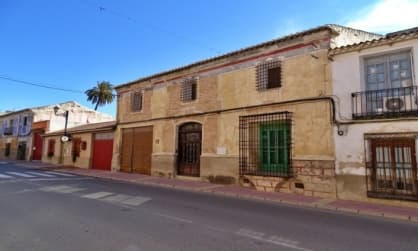
What to see in Librilla
Saint Bartholomew Church

Saint Bartholomew the Apostle is the patron saint of Librilla, and this church is the most emblematic building in the town.
We find it in the old town, at the point known as “El Plano”, a privileged setting next to the “Rambla del Orón”, where the town hall is also located.
This is where the Patron Saint Festivities are traditionally celebrated in honour of Saint Bartholomew.
We find it in the old town, at the point known as “El Plano”, a privileged setting next to the “Rambla del Orón”, where the town hall is also located.
This is where the Patron Saint Festivities are traditionally celebrated in honour of Saint Bartholomew.
The church is built in the shape of a Latin cross, on the remains of old buildings. The decoration style is neoclassical, although it also has baroque touches, typical of the time when it was built.
This church had images of Salzillo, Roque López, and Sánchez Tapia, but unfortunately, most of these works of art were destroyed during the Civil War. The interior was completely renovated when the war ended.
The most prominent sculpture is the image of Saint Bartholomew. This is in the dressing room in front of the altar. It is a polychrome wooden image dating from 1946.
Town Hall of Librilla

This is a building from the 30s, although it has been remodelled. Of the original remains only the clock tower, which still works perfectly.
It is built with exposed brick and has an archway that leads to Church Square. The large palm tree in front of its main facade also stands out.
The Librilla Town Hall building is located in Juan Carlos I Square.
It is built with exposed brick and has an archway that leads to Church Square. The large palm tree in front of its main facade also stands out.
The Librilla Town Hall building is located in Juan Carlos I Square.
Marquis of Camachos House

This is an old mansion built in 1598, as can be seen on the plaque on its façade.
The house still belongs to the descendants of Pedro Rosique and Hernández, the Marquis of Camachos, a noble character who gave his name to Camachos Square in Murcia, which had a large amount of farmland and houses in this town.
The house is a great example of the urban architecture of the time.
The house still belongs to the descendants of Pedro Rosique and Hernández, the Marquis of Camachos, a noble character who gave his name to Camachos Square in Murcia, which had a large amount of farmland and houses in this town.
The house is a great example of the urban architecture of the time.
Formerly in its great hall, which was decorated with large mirrors that covered the walls from ceiling to floor, sumptuous dances were held.
Stables House

This inn with stables was built at the request of José María Álvarez de Toledo y Gonzaga, Duke of Alba, Lord of Librilla, who had two bread ovens, an oil mill, an inn, and a main house in the villa, in front of the old square.
It is estimated that it was built in the 1780s and arose as part of the town's economic boom thanks to the public markets, which attracted many people who later needed a rest area—especially those who had to continue their journey to Andalusia.
It is estimated that it was built in the 1780s and arose as part of the town's economic boom thanks to the public markets, which attracted many people who later needed a rest area—especially those who had to continue their journey to Andalusia.
What to see in the Bajo Guadalentin









